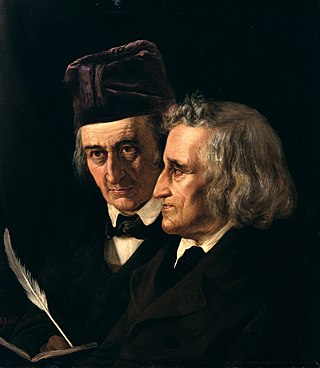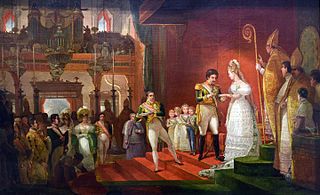Related Research Articles

Jacob Ludwig Karl Grimm, also known as Ludwig Karl, was a German author, linguist, philologist, jurist, and folklorist. He formulated Grimm's law of linguistics, and was the co-author of the Deutsches Wörterbuch, the author of Deutsche Mythologie, and the editor of Grimms' Fairy Tales. He was the older brother of Wilhelm Grimm; together, they were the literary duo known as the Brothers Grimm.

The Brothers Grimm, Jacob (1785–1863) and Wilhelm (1786–1859), were German academics who together collected and published folklore. The brothers are among the best-known storytellers of folktales, popularizing stories such as "Cinderella", "The Frog Prince", "Hansel and Gretel", "Town Musicians of Bremen", "Little Red Riding Hood", "Rapunzel", "Rumpelstiltskin", "Sleeping Beauty", and "Snow White". Their first collection of folktales, Children's and Household Tales, began publication in 1812.

Wilhelm Carl Grimm was a German author and anthropologist. He was the younger brother of Jacob Grimm, of the literary duo the Brothers Grimm.

"Sleeping Beauty", also titled in English as The Sleeping Beauty in the Woods, is a fairy tale about a princess cursed by an evil fairy to sleep for a hundred years before being awakened by a handsome prince. A good fairy, knowing the princess would be frightened if alone when she wakes, uses her wand to put every living person and animal in the palace and forest asleep, to awaken when the princess does.

A stepmother, stepmum or stepmom is a female non-biological parent married to one's preexisting parent. Children from her spouse's previous unions are known as her stepchildren. A stepmother-in-law is a stepmother of one's spouse.

"Hansel and Gretel" is a German fairy tale collected by the Brothers Grimm and published in 1812 as part of Grimms' Fairy Tales. It is also known as Little Step Brother and Little Step Sister.

"Rapunzel" is a German fairy tale most notably recorded by the Brothers Grimm and published in 1812 as part of Children's and Household Tales. The Brothers Grimm's story was developed from the French literary fairy tale of Persinette by Charlotte-Rose de Caumont de La Force (1698), which itself is an alternative version of the Italian fairy tale Petrosinella by Giambattista Basile (1634).
Jack David Zipes is a literary scholar and author. He is a Professor Emeritus in the Department of German, Nordic, Slavic and Dutch at the University of Minnesota.

Grimms' Fairy Tales, originally known as the Children's and Household Tales, is a German collection of fairy tales by the Brothers Grimm, Jacob and Wilhelm, first published on 20 December 1812. Vol. 1 of the first edition contained 86 stories, which were followed by 70 more tales, numbered consecutively, in the 1st edition, Vol. 2, in 1815. By the seventh edition in 1857, the corpus of tales had expanded to 200 tales and 10 "Children's Legends". It is listed by UNESCO in its Memory of the World Registry.

"Jorinde and Joringel" is a German fairy tale collected by the Brothers Grimm. It is Aarne–Thompson 405. The tale is found virtually exclusively in Germany, barring a Swedish variant, although Marie Campbell found a variant in Kentucky, "The Flower of Dew". The story is known in many English translations as "Jorinda and Jorindel".

"The Juniper Tree" is a German fairy tale published in Low German by the Brothers Grimm in Grimm's Fairy Tales in 1812. The story contains themes of child abuse, murder, cannibalism and biblical symbolism and is one of the Brothers Grimm's darker and more mature fairy tales.

"The Wolf and the Seven Young Goats" is a fairy tale collected by the Brothers Grimm and published in Grimm's Fairy Tales. It is of Aarne-Thompson type 123 "The Wolf and the Kids".

The Wonderful World of the Brothers Grimm is a 1962 American Biographical fantasy film directed by Henry Levin and George Pal. The latter was the producer and also in charge of the stop motion animation. The film was one of the highest-grossing films of 1962. It won one Oscar and was nominated for three additional Academy Awards. The cast included several prominent actors—including Laurence Harvey, Karlheinz Böhm, Jim Backus, Barbara Eden and Buddy Hackett.

"Cat and Mouse in Partnership" is a German fairy tale collected by the Brothers Grimm in Grimms' Fairy Tales. It is a story of Aarne-Thompson type 15.
"Thumbling," published in German as "Daumesdick" is a German fairy tale collected by the Brothers Grimm in Grimm's Fairy Tales in 1819. The Grimms included another, similar story, "Thumbling's Travels." Both stories are related to the English Tom Thumb and often share its title when translated into English.
"The Turnip" is a German fairy tale collected by the Brothers Grimm in Grimm's Fairy Tales.

Once Upon a Brothers Grimm is a 1977 American made-for-television musical fantasy film starring Dean Jones and Paul Sand, directed by Norman Campbell. It follows the Brothers Grimm as they make their way to a king's palace with their magical world of fairy tales. The music was written by Mitch Leigh with lyrics by Sammy Cahn. The two-hour film premiered on CBS on November 23, 1977.

The German Fairy Tale Route is a tourist attraction in Germany originally established in 1975. With a length of 600 kilometres (370 mi), the route runs from Hanau in central Germany to Bremen in the north. Tourist attractions along the route are focused around the brothers Wilhelm and Jacob Grimm, including locations where they lived and worked at various stages in their life, as well as regions which are linked to the fairy tales found in the Grimm collection, such as The Town Musicians of Bremen. The Verein Deutsche Märchenstraße society, headquartered in the city of Kassel, is responsible for the route, which travellers can recognize with the help of road signs depicting the heart-shaped body and head of a pretty, princess-like creature.

"The Grave Mound" is a German fairy tale collected by the Brothers Grimm, KHM 195. It is Aarne-Thompson type 779, Divine Rewards and Punishments.
A Tale Dark & Grimm is an animated television series based on the children's book of the same name by Adam Gidwitz. Developed for Netflix by Doug Langdale and Simon Otto, the series premiered on October 8, 2021. Netflix did not renew the show for a second season.
References
- ↑ Zipes, Jack (1988). The Brothers Grimm: from enchanted forests to the modern world. New York: Routledge. pp. 2–3. ISBN 978-0-415-90081-2.